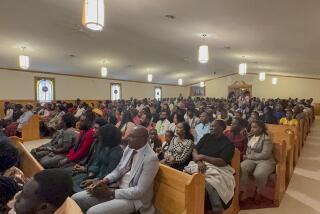Builders dream of a better Haiti
Reporting from Port-Au-Prince, Haiti â The first e-mail went out within hours of the Jan. 12 earthquake, calling together some of Haitiâs most prominent architects, engineers and urban planners. The next day, 50 people showed up at a house in the hillside suburb of Petionville and went to work.
They have met every day since, gathering around a table in a courtyard under the shade of a spreading almond tree. Their goal is simple. It is also audacious. They want to plan a new Haiti.
And not just new buildings. A new economy, a new political culture, a new way of thinking. And yes, a Haiti that would look very different from the one that existed before the quake.
âWe donât want to talk about rebuilding,â said the groupâs guiding spirit, industrial engineer Jean-Marie Raymond Noel. âWe want to talk about a new project, a new vision. . . . We canât hope to be in the same situation as before the quake. It was not good.â
The structural losses that Haiti suffered in the magnitude 7.0 quake are incalculable. The National Palace is in ruins. So is Parliament, the nationâs highest court, the Roman Catholic cathedral, virtually all of the downtown commercial district, the cityâs biggest and most modern supermarket, countless schools, banks, hotels, churches and, of course, homes in what is the Western Hemisphereâs poorest country.
No one wants to talk about the disaster as an opportunity, exactly. To begin with, it seems insensitive, considering that more than 150,000 people died in the quake and many of their bodies remain entombed in the rubble of the buildings that collapsed.
In addition, no one knows where Haiti will come up with the money to rebuild, or how much it will cost. Prime Minister Jean-Max Bellerive launched that effort Monday when he appealed to international donors in Montreal for money to recover from the quake.
But one way or another, this country will have to build a new capital, or at least a big chunk of one. There is talk of moving it somewhere else, starting fresh, but that seems unlikely. And so the people who plan and build are starting to dream.
They look to the way Japan and Germany were reborn out of the rubble of World War II and think: Why not Haiti?
âWe want another country,â said Marie Daniele, a Port-au-Prince architect who attends the daily meetings in Petionville. âEveryone here wants another country, with rules, and a strong government to apply them.â
By rules, Daniele was talking in part about a building code. Sitting a couple of seats away from her at a planning group meeting Monday was Leslie Voltaire, Haitiâs special envoy to the United Nations. He scoffed at the mention of a code.
âThere is a two-page building code,â he said dismissively, âthat nobody used.â
The architects began murmuring in dissent. Voltaire corrected himself. âThe professionals used it,â he said. âBut the professionals build 5% of the buildings.â
Anyway, Voltaire acknowledged, the building code really wasnât made with earthquakes in mind. Hurricanes were the big fear here, and with good reason: Haiti has been pounded repeatedly by devastating storms, including four in 2008 alone.
So people built with cinder blocks and cement, the heavier the better. Most builders lacked the money for substantial reinforcement. When the quake hit, multistory buildings collapsed into single-story slabs of compressed rubble.
The planners would like to explore using other materials, perhaps bamboo. Steel probably will remain too expensive for most Haitians, they said. But some kind of change is necessary, and it needs oversight and enforcement.
âThis is the big challenge,â said Daniele. âChange the mentality.â
That is just one of the challenges, of course. There is also the cost of rebuilding, which by anyoneâs estimate is far beyond the countryâs means. There is the daunting physical challenge of demolishing the thousands of buildings that are damaged beyond repair and cleaning up the rubble. And of course there is the challenge of resettling an estimated 700,000 people left homeless in the Port-au-Prince area.
Noel said the planning group grew out of an organization he leads, the Committee for Support of Municipalities. It had about 100 members and its weekly executive board meetings used to involve the nine board members and perhaps a few others.
But right after the quake, âWe made a call for architects, engineers and urban planners to come together and try to bring an appropriate and adequate response to this tragedy,â he said. The response was gratifying.
That first day after the quake, he said, people gathered in the courtyard they are borrowing from a physical therapy center and began to talk. It was loose and informal: Members would drift in and out as they went to search for loved ones missing in the quake.
But they kept coming back, day after day, arriving in the late morning, sometimes staying until 5 p.m., forming committees and preparing proposals, the first of which they plan to send to the government today.
That proposal is more technical than visionary, dealing with how to mobilize the country and solicit international aid.
But the group is kicking around some far-reaching ideas, and although it has no official standing, it has captured the ear of the government, including Voltaire.
The envoy participated in planning that led to a blueprint for a new Haitian economy, built around sustainable agriculture, tourism, technology, textile exports and perhaps further development of port facilities. Voltaire envisions a less centralized Haiti, with more urban dwellers moving back to the countryside and taking some pressure off Port-au-Prince, which had a population of 2 million before the quake.
The architects and others in the planning group agree. They also envision a new Port-au-Prince that might bear only a passing resemblance to the vibrant but teeming and chaotic capital that existed before the quake.
âI see Port-au-Prince not with big buildings,â said architect Winifred Galvan. âI see Port-au-Prince with the central palace and those things, but . . . with less people than it had before.â
Galvan sees townhouses built where larger apartment buildings once stood, and collapsed buildings replaced with parks and social service offices.
She sees a seaside promenade and imagines tourists flocking to a place that once was a regular travel destination, but has long been shunned by the Caribbean getaway crowd.
She knows this isnât likely to happen for a long time, if ever. But it seems as good a time as any to dream.
More to Read
Sign up for Essential California
The most important California stories and recommendations in your inbox every morning.
You may occasionally receive promotional content from the Los Angeles Times.










